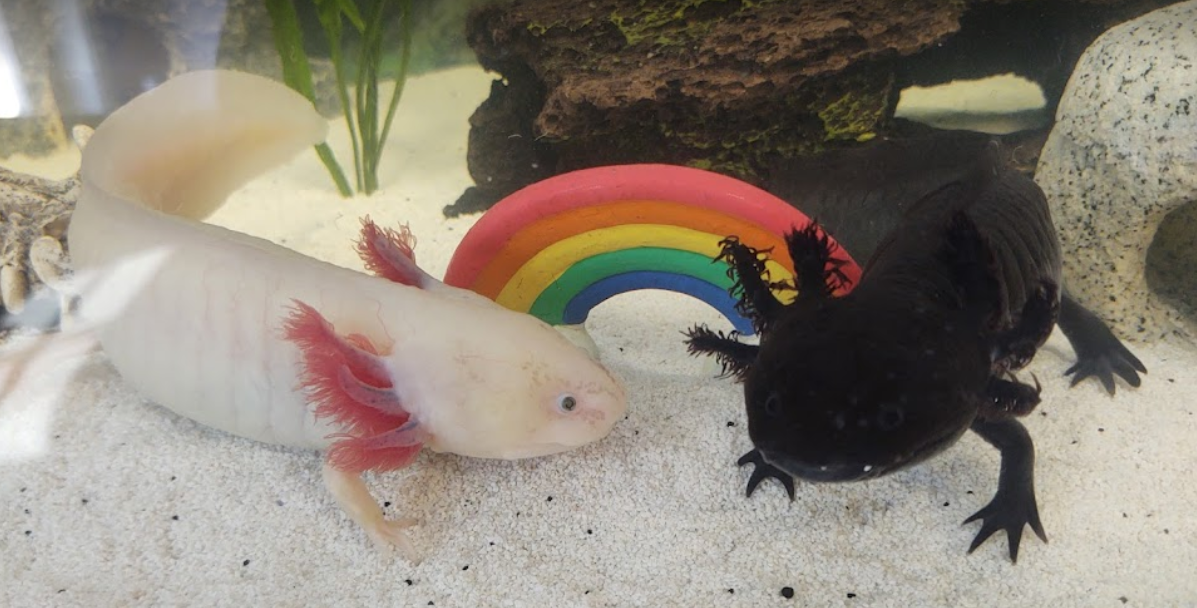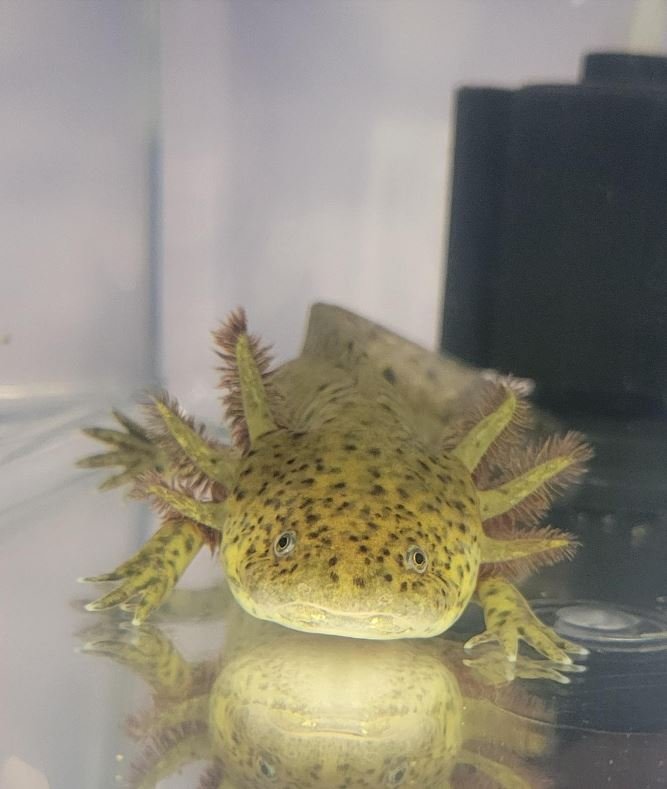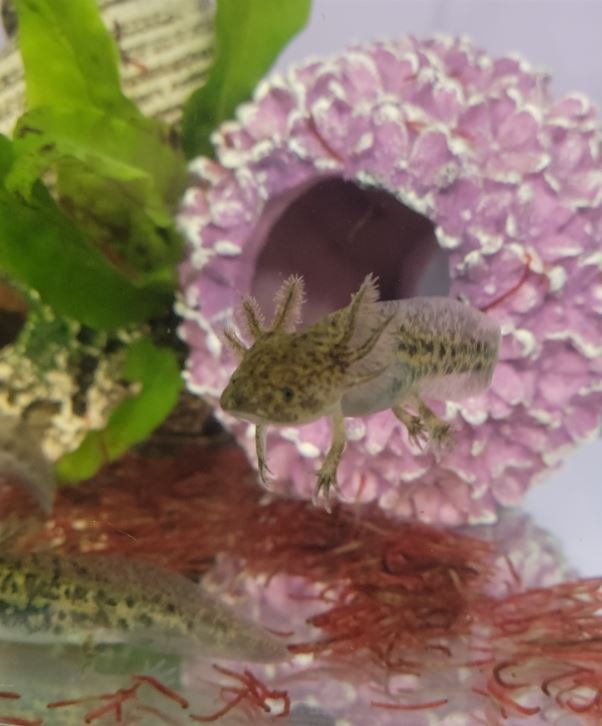
About the Axolotl
(Ambystoma Mexicanum)
What is an Axolotl?
Axolotls (pronounced ak·suh·laa·tls) are aquatic salamanders that are found in the wild in only one place, Lake Xochimilco in Mexico City. These critically endangered amphibians are also popular as pets and are bred in captivity for scientific research due to their unique ability to regrow body parts. Habitat destruction and the introduction of invasive fish species have led to a dramatic decline in the axolotl population.
These amphibians come in a range of colors and maintain their larval traits throughout their entire lives. Their unusual appearance, often featuring bright pink skin and frilly headdresses (which are their gills, in fact), has made them beloved by many fans around the world. These solitary animals are not unfriendly or antisocial, but they're also quite happy to be left alone. They are fully aquatic, so if you keep them as a pet, you will not be able to have direct interaction, but they are entertaining to watch.
Is it true that Axolotls can “regenerate body parts”?
A number of amphibians and fish are capable of regenerating tails and limbs, but axolotls take this ability up a notch by regenerating jaws, spinal cords, skin, ovary and lung tissue, and even portions of their hearts and brains. What's more, an axolotl can continue to regenerate throughout its life.
The regenerative abilities of the Axolotl’s cells are of significant interest to researchers hoping to translate this ability to humans. This is a remarkable capability: "If an axolotl loses a limb, the appendage will grow back, at just the right size and orientation. Within weeks, the seam between old and new disappears completely."
With 32 billion DNA bases and a genome 10 times the size of a human’s, sequencing the DNA of axolotls is a challenge for scientists. But it's an important one, as it will help researchers discover how the axolotl uses stem cells to regenerate tissue. Scientists have already identified two genes used in regeneration in axolotls. Because the regenerative abilities of axolotls are so impressive, scientists continue to expand their research to include other internal organs and retina regeneration.
Smithsonian describes them as being ubiquitous in research labs—"basically the white mice of amphibians, thanks to their unique genetic profile and their potential to unlock the secrets of evolution and regeneration."
For how long do Axolotls live?
In the wild, axolotls live for 5 to 10 years, but if properly cared for in captivity, they tend to live anywhere from 10 to 15 years.
What water conditions do Axolotls need?
Put simply; axolotls live in cold, dark, fresh, low-current water.
Water flow is usually caused by a filter or when you use an air pump on an aquarium. Output from a filter can cause significant flow and this is perhaps the most common cause of stress in axolotls. Excessive water flow can also lead to disease.
The optimum environmental temperature for axolotls is 60-65°F and should never exceed 75°F.
The ideal water pH is 7.4-7.6.
Chlorine, as found in tap water, is harmful to axolotls and so either a de-chlorinator must be used, or the water must be left to stand for 24 hours before adding it to the tank. If you live in an area in which chloramines are added to the water then a dechlorinator is essential.
Ammonia, NH3, the main waste product produced by your axolotls, is very toxic in its unionised form (NH3 as opposed to NH4+). A low pH means a higher concentration of H+ ions, which in turn results in a higher degree of ionisation of NH3 to NH4+. Conversely, a high pH means that unionised ammonia, toxic NH3, is the main form of ammonia. What this means in English is that the higher the pH, the more toxic the ammonia. Ammonia can kill, and at a pH of 8 or more, it kills even more effectively. Water temperature can also affect its toxicity, a higher temperature resulting in a higher toxicity. Unless you're extremely proficient with maintaining aquarium systems, a periodic ammonia test is advisable. Even the most experienced hobbyist should occasionally test for ammonia.
Nitrite, NO2-, is produced from ammonia by the bacterium Nitrosomonas. It is not as toxic as ammonia, but should also be tested for regularly.
10-20% of the water should be changed every week, although this can be altered depending on the filter system of the tank.
Nitrate, NO3-, is the least toxic of this family of nitrogenous compounds. It is produced from nitrite by the bacterium Nitrobacter. Although it should be tested for, regular water changes and plants in the aquarium will keep the levels of nitrate in check. Although not toxic at low levels, if let build up through lack of water changes, it too can be dangerous, and high levels usually lead to blooms of algae.
What do Axolotls eat?
Axolotls are carnivorous—they eat everything from fish and worms to insects and crustaceans. They aren’t especially picky and will eat meat that is dead or alive. In captivity, they frequently eat brine shrimp, bloodworms, blackworms, earthworms, fish pellets, and more. Young axolotls, and those with an inadequate food supply, can be cannibalistic, biting off an appendage of a nearby family member.
Can I touch or handle an Axolotl?
Because of their delicate, soft bodies, it is best not to touch axolotls in order to keep them safe and unharmed. Axolotls should undergo minimal handling since their skin is susceptible to toxins. Only handle them if it's absolutely necessary. If you do need to touch your axolotl, thoroughly wash your hands before and after handling them.
What do I need for my Axolotl’s tank?
At least a 15- to 20-gallon fish tank is recommended for an adult axolotl. If you choose to keep more than one, your tank should increase by ten gallons for each axolotl added. Make sure the tank has a secure lid, as it's not uncommon for these animals to try to jump out of their enclosure. An above-water land area is unnecessary for these fully aquatic animals. At a minimum, the water depth should be slightly more than the length of your axolotl. But adding extra depth will help with water quality and give your animal more room to move. Fine sand works great as a substrate. Some owners opt to leave the bottom of the tank bare, though others believe this might stress the axolotl if it can't get a foothold on the smooth bottom. We do NOT recommend gravel, as it might be ingested and cause an obstruction. Hiding spots are important for axolotls; caves, pots, and live plants work perfectly. No special lighting is required for axolotls.
Do Axolotls need fish friends or tank mates?
Axolotls tend to be fairly bold and are perfectly content to move about their tank as they're being watched by their humans. Some will come up to the side of their tank when a person is there observing them. However, they aren’t particularly social animals and don’t require any tank companions. They should not be kept with other species as axolotls might try to eat pet fish, and the fish sometimes nip at them. You even should be cautious about housing them with other axolotls. Juvenile axolotls can be cannibalistic toward one another, so they are best raised in separate enclosures. Adults can potentially be housed together, but still, watch out for cannibalistic tendencies. If a body part gets bitten off by a tank mate, an axolotl actually can regenerate it over time. However, it's still best to avoid this situation altogether.
Sources:
https://www.treehugger.com/things-you-dont-know-about-axolotl-4863490
https://www.rvc.ac.uk/Media/Default/small-animal/documents/Axolotl%20care.pdf
https://www.axolotl.org/requirements.htm
https://www.thesprucepets.com/axolotls-as-pets-1236714
https://www.cbreptile.com/axolotl-tank/?gad_source=1&gclid=CjwKCAiA75itBhA6EiwAkho9e3RCYbLilzG7x6TU6YU9QXpP7JuRqsNO_1uweibY8lIPvp3SvO8p0xoCurYQAvD_BwE







